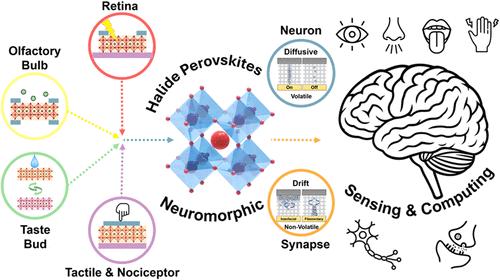Halide Perovskites for Neuromorphic Sensing and Computing
IF 8.2
2区 材料科学
Q1 MATERIALS SCIENCE, MULTIDISCIPLINARY
引用次数: 0
Abstract
The development of semiconductor-based electronic devices has significantly advanced sensor-based data acquisition and processor-driven data analysis. However, conventional complementary metal-oxide-semiconductor technologies are now facing fundamental limitations in scaling, speed, and power efficiency. In response, neuromorphic sensing and computing devices inspired by biological nervous systems have emerged as promising alternatives to address these challenges. Among various material platforms, halide perovskites (HPs) have attracted significant attention for neuromorphic applications owing to their unique properties, including low activation energies, tunable bandgaps, facile ion migration, and mechanical flexibility. These characteristics render HPs well suited for the development of neuromorphic sensors capable of mimicking human sensory functions such as vision, olfaction, gustation, and tactile perception, as well as memristive devices for energy-efficient in-memory computing. This review provides a comprehensive overview of recent advances in HP-based neuromorphic sensing and computing technologies, with a focus on their distinct structural and electronic properties, fundamental operation mechanisms, and cutting-edge applications. Current challenges and future perspectives are also discussed, highlighting the transformative potential of HP-based neuromorphic systems for next-generation sensing and computing.

用于神经形态传感和计算的卤化物钙钛矿
以半导体为基础的电子器件的发展,极大地促进了基于传感器的数据采集和处理器驱动的数据分析。然而,传统的互补金属氧化物半导体技术现在在规模、速度和功率效率方面面临着根本性的限制。作为回应,受生物神经系统启发的神经形态传感和计算设备已经成为解决这些挑战的有希望的替代方案。在各种材料平台中,卤化物钙钛矿(HPs)由于其独特的性质,包括低活化能、可调带隙、易于离子迁移和机械灵活性,在神经形态应用中引起了极大的关注。这些特性使得HPs非常适合于开发能够模仿人类感官功能(如视觉、嗅觉、味觉和触觉)的神经形态传感器,以及用于节能内存计算的记忆装置。本文综述了基于hp的神经形态传感和计算技术的最新进展,重点介绍了它们独特的结构和电子特性、基本运行机制和前沿应用。本文还讨论了当前的挑战和未来的前景,强调了基于hp的神经形态系统在下一代传感和计算方面的变革潜力。
本文章由计算机程序翻译,如有差异,请以英文原文为准。
求助全文
约1分钟内获得全文
求助全文
来源期刊

ACS Applied Materials & Interfaces
工程技术-材料科学:综合
CiteScore
16.00
自引率
6.30%
发文量
4978
审稿时长
1.8 months
期刊介绍:
ACS Applied Materials & Interfaces is a leading interdisciplinary journal that brings together chemists, engineers, physicists, and biologists to explore the development and utilization of newly-discovered materials and interfacial processes for specific applications. Our journal has experienced remarkable growth since its establishment in 2009, both in terms of the number of articles published and the impact of the research showcased. We are proud to foster a truly global community, with the majority of published articles originating from outside the United States, reflecting the rapid growth of applied research worldwide.
 求助内容:
求助内容: 应助结果提醒方式:
应助结果提醒方式:


